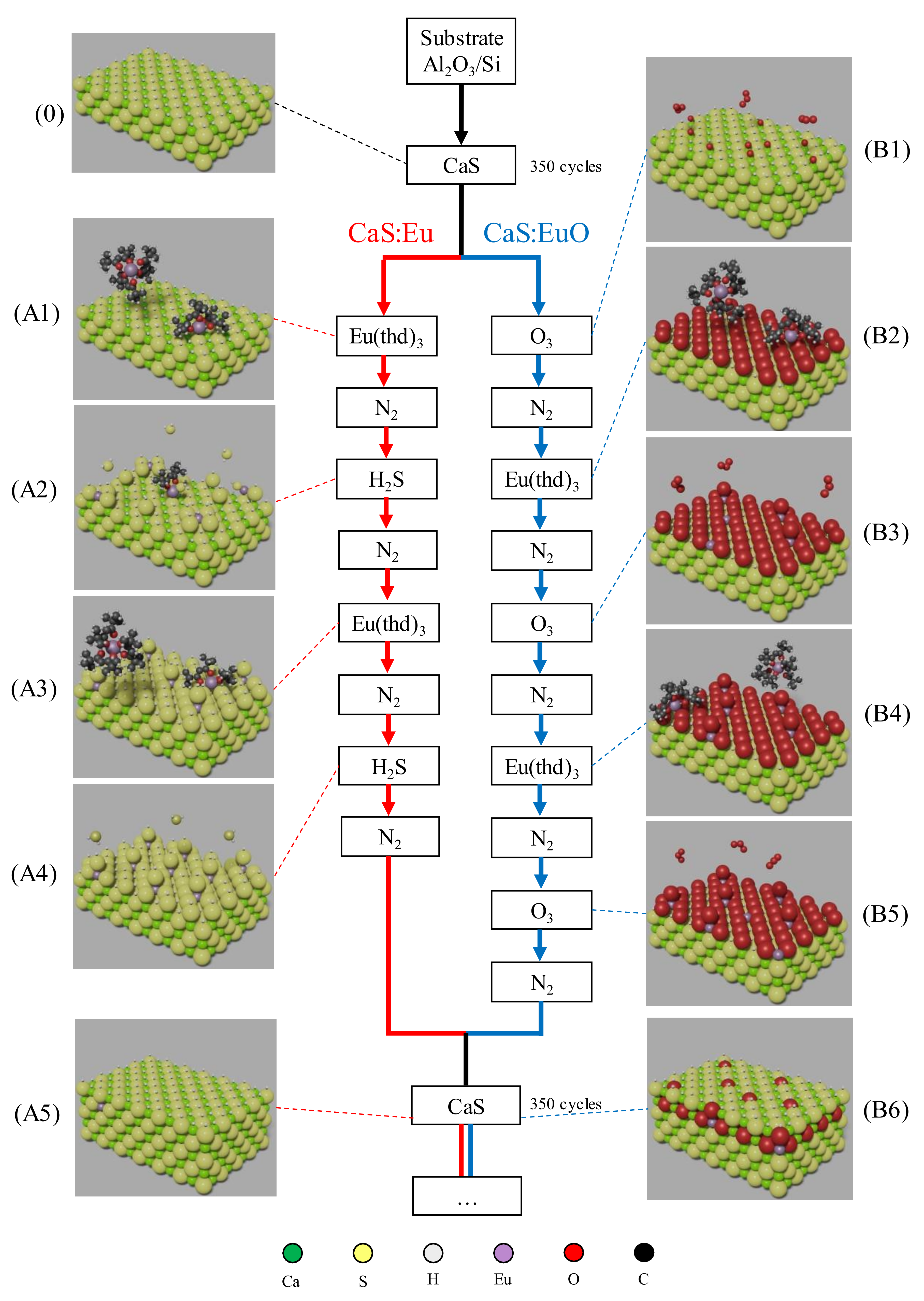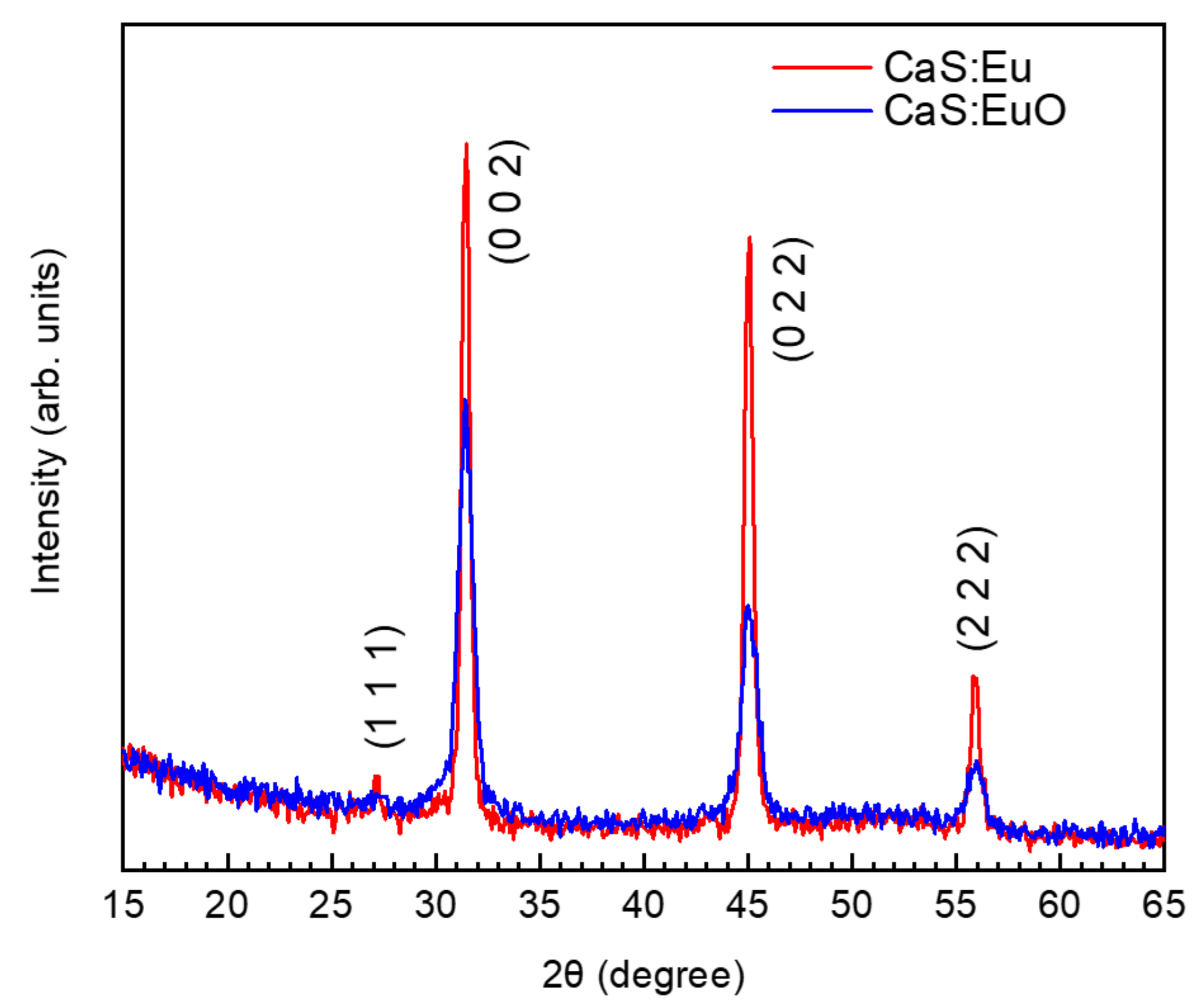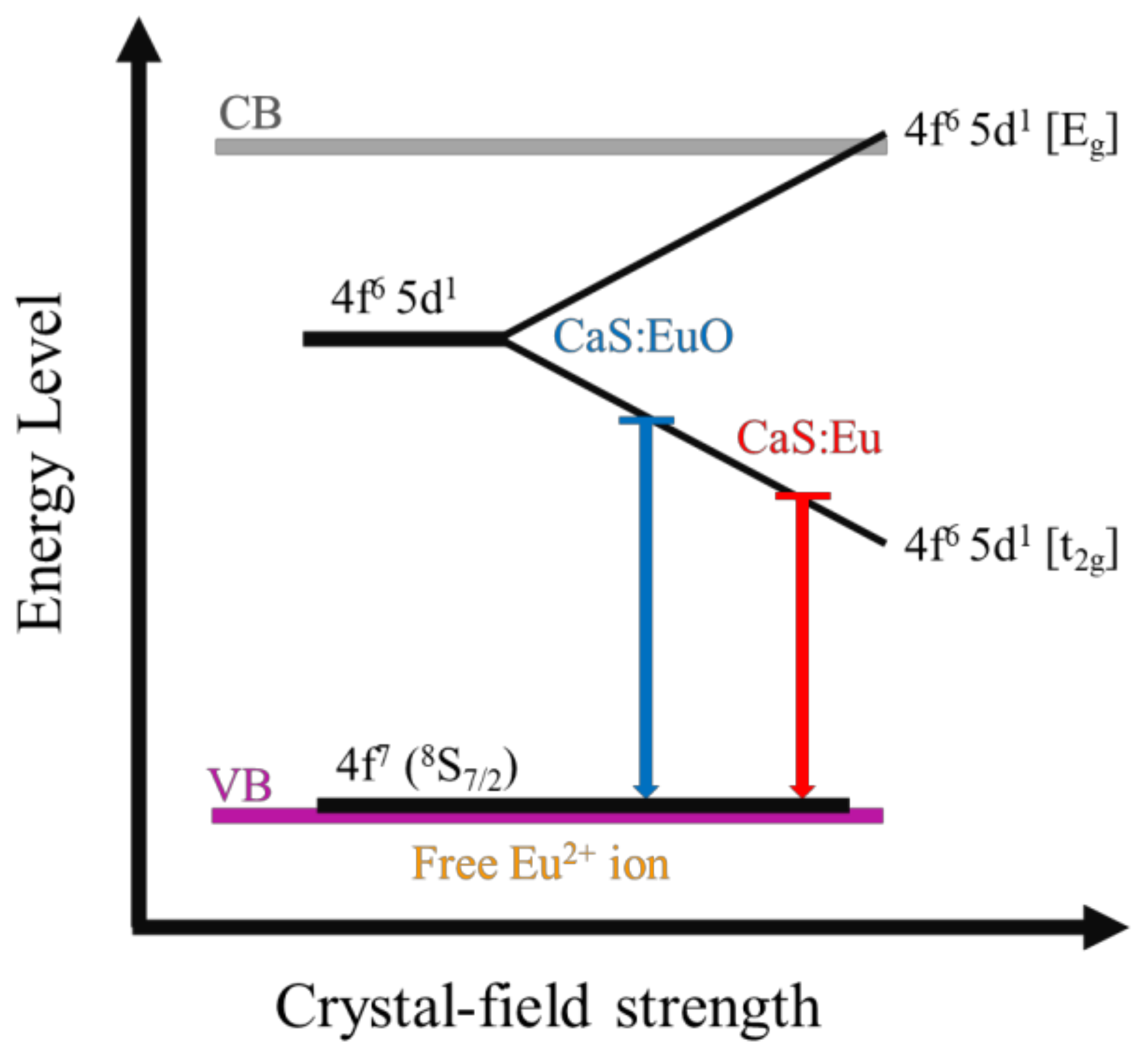Tuning of Emission Wavelength of CaS:Eu by Addition of Oxygen Using Atomic Layer Deposition
Abstract
:1. Introduction
2. Materials and Methods
3. Results
3.1. Crystallinity
3.2. Chemical Analysis
3.3. Photoluminescence
4. Discussion
5. Conclusions
Author Contributions
Funding
Institutional Review Board Statement
Informed Consent Statement
Data Availability Statement
Acknowledgments
Conflicts of Interest
References
- Puurunen, R.L. A Short History of Atomic Layer Deposition: Tuomo Suntola’s Atomic Layer Epitaxy. Chem. Vap. Depos. 2014, 20, 332–344. [Google Scholar] [CrossRef] [Green Version]
- Leskelä, M.; Mattinen, M.; Ritala, M. Review Article: Atomic layer deposition of optoelectronic materials. J. Vac. Sci. Technol. B 2019, 37, 030801. [Google Scholar] [CrossRef] [Green Version]
- Ritala, M.; Leskela, M. Chapter 2: Atomic Layer Deposition; Academic Press: San Diego, CA, USA, 2002; ISBN 0-12-512909-2. [Google Scholar]
- Ritala, M.; Kukli, K.; Rahtu, A.; Räisänen, P.I.; Leskelä, M.; Sajavaara, T.; Keinonen, J. Atomic Layer Deposition of Oxide Thin Films with Metal Alkoxides as Oxygen Sources. Science 2000, 288, 319–321. [Google Scholar] [CrossRef] [PubMed]
- Van, T.T.; Chang, J.P. Controlled erbium incorporation and photoluminescence of Er-doped Y2O3. Appl. Phys. Lett. 2005, 87, 11907. [Google Scholar] [CrossRef]
- Rönn, J.; Karvonen, L.; Kauppinen, C.; Perros, A.P.; Peyghambarian, N.; Lipsanen, H.; Säynätjoki, A.; Sun, Z. Atomic Layer Engineering of Er-Ion Distribution in Highly Doped Er:Al2O3 for Photoluminescence Enhancement. ACS Photon 2016, 3, 2040–2048. [Google Scholar] [CrossRef]
- Scarafagio, M.; Tallaire, A.; Chavanne, M.-H.; Cassir, M.; Ringuedé, A.; Serrano, D.; Goldner, P.; Ferrier, A. Improving the Luminescent Properties of Atomic Layer Deposition Eu: Y2O3 Thin Films through Optimized Thermal Annealing. Phys. Status Solidi A 2020, 217, 1–7. [Google Scholar] [CrossRef]
- Rönn, J.; Zhang, W.; Autere, A.; Leroux, X.; Pakarinen, L.; Alonso-Ramos, C.; Säynätjoki, A.; Lipsanen, H.; Vivien, L.; Cassan, E.; et al. Ultra-high on-chip optical gain in erbium-based hybrid slot waveguides. Nat. Commun. 2019, 10, 432. [Google Scholar] [CrossRef] [PubMed] [Green Version]
- Tripathi, T.S.; Karppinen, M. Mixed-Anion Compounds: An Unexplored Playground for ALD Fabrication. Adv. Mater. Interfaces 2021, 8, 2100146. [Google Scholar] [CrossRef]
- Cho, G.; Rhee, S.-W. Plasma Enhanced Atomic Layer Deposition of TiCxNyFilm with Various Reactive Gases. ECS J. Solid State Sci. Technol. 2014, 3, P185–P191. [Google Scholar] [CrossRef] [Green Version]
- Choi, Y.-J.; Park, H.-H. A simple approach to the fabrication of fluorine-doped zinc oxide thin films by atomic layer deposition at low temperatures and an investigation into the growth mode. J. Mater. Chem. C 2014, 2, 98–108. [Google Scholar] [CrossRef]
- Tao, J.-J.; Ma, H.-P.; Yuan, K.-P.; Gu, Y.; Lian, J.-W.; Li, X.-X.; Huang, W.; Nolan, M.; Lu, H.-L.; Zhang, D.-W. Modification of 1D TiO2 nanowires with GaOxNy by atomic layer deposition for TiO2@GaOxNy core–shell nanowires with enhanced photoelectrochemical performance. Nanoscale 2020, 12, 7159–7173. [Google Scholar] [CrossRef]
- Closser, R.G.; Bergsman, D.S.; Bent, S.F. Molecular Layer Deposition of a Highly Stable Silicon Oxycarbide Thin Film Using an Organic Chlorosilane and Water. ACS Appl. Mater. Interfaces 2018, 10, 24266–24274. [Google Scholar] [CrossRef]
- Rosa, J.; Deuermeier, J.; Soininen, P.J.; Bosund, M.; Zhu, Z.; Fortunato, E.; Martins, R.; Sugiyama, M.; Merdes, S. Control of Eu Oxidation State in Y2O3−xSx:Eu Thin-Film Phosphors Prepared by Atomic Layer Deposition: A Structural and Photoluminescence Study. Materials 2019, 13, 93. [Google Scholar] [CrossRef] [PubMed] [Green Version]
- Burbano, D.C.R.; Sharma, S.K.; Dorenbos, P.; Viana, B.; Capobianco, J.A. Persistent and Photostimulated Red Emission in CaS:Eu2+,Dy3+ Nanophosphors. Adv. Opt. Mater. 2015, 3, 551–557. [Google Scholar] [CrossRef]
- Gao, Y.; Li, R.; Zheng, W.; Shang, X.; Wei, J.; Zhang, M.; Xu, J.; You, W.; Chen, Z.; Chen, X. Broadband NIR photostimulated luminescence nanoprobes based on CaS:Eu2+,Sm3+ nanocrystals. Chem. Sci. 2019, 10, 5452–5460. [Google Scholar] [CrossRef] [PubMed] [Green Version]
- Wang, J.; Zhu, Y.; Grimes, C.A.; Cai, Q. Multicolor lanthanide-doped CaS and SrS near-infrared stimulated luminescent nanoparticles with bright emission: Application in broad-spectrum lighting, information coding, and bio-imaging. Nanoscale 2019, 11, 12497–12501. [Google Scholar] [CrossRef]
- Suresh, K.; Murthy, K.V.R.; Rao, A.; Poornachandra, R.N.V. Rare Earth Doped Alkali Earth Sulfide Phosphors for White-Light LEDs. ISRN Condens. Matter Phys. 2011, 2011, 392917. [Google Scholar] [CrossRef] [Green Version]
- Guo, C.; Huang, D.; Su, Q. Methods to improve the fluorescence intensity of CaS:Eu2+ red-emitting phosphor for white LED. Mater. Sci. Eng. B 2006, 130, 189–193. [Google Scholar] [CrossRef]
- Tanaka, K.; Mikami, A.; Ogura, T.; Taniguchi, K.; Yoshida, M.; Nakajima, S. High brightness red electroluminescence in CaS:Eu thin films. Appl. Phys. Lett. 1986, 48, 1730–1732. [Google Scholar] [CrossRef]
- Abe, Y.; Onisawa, K.-I.; Ono, Y.A.; Hanazono, M. Effects of Oxygen in CaS:Eu Active Layers on Emission Properties of Thin Film Electroluminescent Cells. Jpn. J. Appl. Phys. 1990, 29, 1495–1498. [Google Scholar] [CrossRef]
- Poelman, D.; Vercaemst, R.; van Meirhaeghe, R.; Laflère, W.; Cardon, F. Influence of the growth conditions on the properties of CaS:Eu electroluminescent thin films. J. Lumin 1997, 75, 175–181. [Google Scholar] [CrossRef]
- Poelman, D.; van Haecke, J.E.; Smet, P. Advances in sulfide phosphors for displays and lighting. J. Mater. Sci. Mater. Electron. 2009, 20, 134–138. [Google Scholar] [CrossRef]
- Dorenbos, P. Energy of the first 4f7→4f65d transition of Eu2+ in inorganic compounds. J. Lumin. 2003, 104, 239–260. [Google Scholar] [CrossRef]
- Sung, H.J.; Cho, Y.S.; Huh, Y.; Do, Y. Preparation, Characterization and Photoluminescence Properties of Ca1-xSrxS:Eu Red-emitting Phosphors for a White LED. Bull. Korean Chem. Soc. 2007, 28, 1280–1284. [Google Scholar] [CrossRef] [Green Version]
- Lin, J.; Huang, Y.; Mi, J.; Zhang, X.; Lu, Z.; Xu, X.; Fan, Y.; Zou, J.; Tang, C. BN-coated Ca1−xSrxS:Eu solid-solution nanowires with tunable red light emission. Nanotechnology 2013, 24, 405701. [Google Scholar] [CrossRef]
- Sun, B.; Yi, G.; Chen, D.; Zhou, Y.; Cheng, J. Synthesis and characterization of strongly fluorescent europium-doped calcium sulfide nanoparticles. J. Mater. Chem. 2002, 12, 1194–1198. [Google Scholar] [CrossRef]
- Rosa, J.; Heikkilä, M.; Sirkiä, M.; Merdes, S. Red Y2O3:Eu-Based Electroluminescent Device Prepared by Atomic Layer Deposition for Transparent Display Applications. Materials 2021, 14, 1505. [Google Scholar] [CrossRef] [PubMed]
- Getz, M.N.; Hansen, P.-A.; Fjellvåg, H.; Nilsen, O. Luminescent properties of europium titanium phosphate thin films deposited by atomic layer deposition. RSC Adv. 2017, 7, 8051–8059. [Google Scholar] [CrossRef] [Green Version]
- Rönn, J.; Zhang, J.; Zhang, W.; Tu, Z.; Matikainen, A.; le Roux, X.; Durán-Valdeiglesias, E.; Vulliet, N.; Boeuf, F.; Ramos, C.A.; et al. Erbium-doped hybrid waveguide amplifiers with net optical gain on fully industrial 300 mm silicon nitride photonic platform. Opt. Express 2020, 28, 27919. [Google Scholar] [CrossRef]
- Sicre, J.E.; Dubois, J.T.; Eisentraut, K.J.; Sievers, R.E. Volatile lanthanide chelates. II. Vapor pressures, heats of vaporization, and heats of sublimation. J. Am. Chem. Soc. 1969, 91, 3476–3481. [Google Scholar] [CrossRef]
- Wyckoff, R.W.G. Crystal Structures, 2nd ed.; Interscience Publishers: New York, NY, USA, 1963. [Google Scholar]
- Naumkin, A.V.; Kraut-Vass, A.; Gaarenstroom, S.W.; Powell, C.J. NIST X-ray Photoelectron Spectroscopy Database, NIST Standard Reference Database Number 20. Available online: https://srdata.nist.gov/xps/citation.aspx (accessed on 2 September 2021).
- Liu, W.-Q.; Wu, D.; Chang, H.; Duan, R.-X.; Wu, W.-J.; Amu, G.; Chao, K.-F.; Bao, F.-Q.; Tegus, O. The Enhanced Red Emission and Improved Thermal Stability of CaAlSiN3:Eu2+ Phosphors by Using Nano-EuB6 as Raw Material. Nanomaterials 2018, 8, 66. [Google Scholar] [CrossRef] [PubMed] [Green Version]
- Nyenge, R.; Swart, H.; Ntwaeaborwa, O. Luminescent properties, intensity degradation and X-ray photoelectron spectroscopy analysis of CaS:Eu2+ powder. Opt. Mater. 2015, 40, 68–75. [Google Scholar] [CrossRef]
- Dezelah, C.L.; Myllymäki, P.; Päiväsaari, J.; Arstila, K.; Niinistö, L.; Winter, C.H. The growth of ErxGa2−xO3 films by atomic layer deposition from two different precursor systems. J. Mater. Chem. 2007, 17, 1308–1315. [Google Scholar] [CrossRef]







| Sample | Pulsing Sequence | Pulsing Time (s) | Number of Cycles per Layer |
|---|---|---|---|
| CaS:Eu | Ca(Thd)2/N2/H2S/N2 | 2/5/0.2/3 | 350 |
| Eu(Thd)3/N2/H2S/N2 | 3/7/0.2/3 | 2 | |
| CaS:EuO | Ca(Thd)2/N2/H2S/N2 | 2/5/0.2/3 | 350 |
| O3/N2/Eu(Thd)3/N2/O3/N2/ Eu(Thd)3/N2/O3/N2 | 3/5/3/7/3/5/3/7/3/5 | 1 |
| Sample | H (at. %) | C (at. %) | O (at. %) | S (at. %) | Ca (at. %) | Eu (at. %) |
|---|---|---|---|---|---|---|
| CaS:Eu | 1.2 ± 0.2 | 0.8 ± 0.3 | 3.2 ± 0.3 | 47.7 ± 0.5 | 47.0 ± 0.5 | 0.13 ± 0.02 |
| CaS:EuO | 4.7 ± 0.3 | 3.4 ± 0.3 | 16.8 ± 0.5 | 37.5 ± 0.5 | 37.4 ± 0.5 | 0.17 ± 0.02 |
| Sample | Excitation Wavelength [nm] | Peak Emission [nm] | Intensity (arb. un.) | Emission Wavelength [nm] | Peak Excitation [nm] | Intensity (arb. un.) |
|---|---|---|---|---|---|---|
| CaS:Eu | 225 | 647 | 93.61 | 640 | 223.6 | 89.17 |
| CaS:EuO | 230 | 625.8 | 19.87 | 630 | 227.2 | 20.49 |
Publisher’s Note: MDPI stays neutral with regard to jurisdictional claims in published maps and institutional affiliations. |
© 2021 by the authors. Licensee MDPI, Basel, Switzerland. This article is an open access article distributed under the terms and conditions of the Creative Commons Attribution (CC BY) license (https://creativecommons.org/licenses/by/4.0/).
Share and Cite
Rosa, J.; Lahtinen, J.; Julin, J.; Sun, Z.; Lipsanen, H. Tuning of Emission Wavelength of CaS:Eu by Addition of Oxygen Using Atomic Layer Deposition. Materials 2021, 14, 5966. https://doi.org/10.3390/ma14205966
Rosa J, Lahtinen J, Julin J, Sun Z, Lipsanen H. Tuning of Emission Wavelength of CaS:Eu by Addition of Oxygen Using Atomic Layer Deposition. Materials. 2021; 14(20):5966. https://doi.org/10.3390/ma14205966
Chicago/Turabian StyleRosa, José, Jouko Lahtinen, Jaakko Julin, Zhipei Sun, and Harri Lipsanen. 2021. "Tuning of Emission Wavelength of CaS:Eu by Addition of Oxygen Using Atomic Layer Deposition" Materials 14, no. 20: 5966. https://doi.org/10.3390/ma14205966







